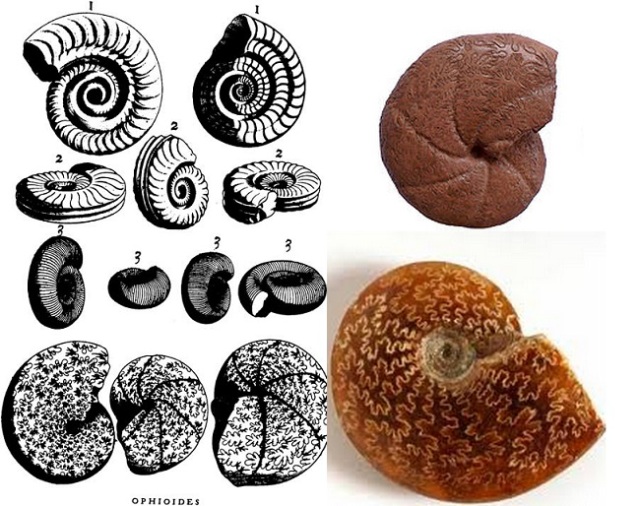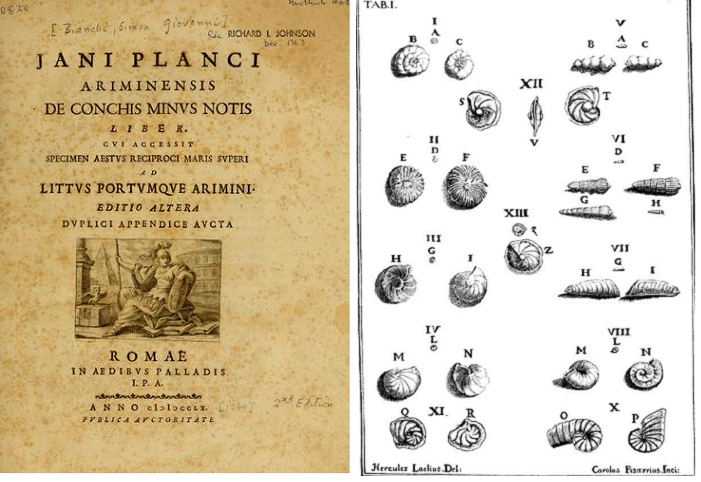Since antiquity, ammonites has been associated with myths, legends, religion and even necromancy. You can find reference to these fossils in the works of Emilio Salgari, Sir Walter Scott, Friedrich Schiller and Johann Wolfgang von Goethe.
From the sixteenth to the late eighteenth centuries, the study of ammonites in Italy was crucial in the debate about the real nature of fossil remains. Leonardo describes the ammonites of the Veronese mountains in the code Hammer (formerly Codex Leicester), folio 9, where he identified these fossils as lithified remains of organisms.
Ulisse Aldrovandi describes several specimens of ammonites in his Musaeum Metallicum. Aldrovandi supported the idea of the inorganic origin of fossils, although he often compared them with existing animals. He recognized some resemblance between ammonites and snakes so he used the term ‘Ophiomorphites’ (or snake-shaped stone).

Ammonites illustration of the Metallotheca Vaticana of Michele Mercati. Two examples of the ammonites described: Calliphylloceras and Phylloceras
In 1574, Michele Mercati organises the famous Metallotheca Vaticana, where describes several ammonites. But he fully embraces the inorganic interpretation of fossils, a real setback with respect to the pioneering hypothesis previously formulated by Leonardo da Vinci. Mercati treats the fossils with he generic term ‘Lapides idiomorphoi’ (stones equipped with proper shape).
In the seventeenth century, the Italian painter Agostino Scilla compiled an enormous body of evidence, well reasoned and convincing, in favour of the organic nature of fossils found on hills and mountains (Romano, 2014). . However, there is no mention of ammonites is his work. Paolo Silvio Boccone (1633–1704) a Sicilian naturalist and botanist, also supported of the organic nature of fossils. In ‘Recherches et Observations Naturelles’ (1674), he wrote that ammonites – at that time called ‘Corne d’Ammone’ or ‘Corne de Belier’– represent models (internal) while the original shells of organisms must have been ‘calcined’ or ‘pulverised’.

Cover of De conchis minus notis and foraminifera of Rimini’s seaside figured by Bianchi (1739, Table I) and attributed by the author to microscopic specimens of ‘Cornu Ammonis’.
In the first half of the eighteenth century, Bartolomeo Beccari began to study tiny shells that could only be observed under the microscope and classified these organisms as microscopic ‘Corni di Ammone’, continuing with the enduring confusion between cephalopods and foraminifera that started in 1565 when Conrad Gesner described the nummulites collected in the surroundings of Paris. Also Giovanni Bianchi (known by the pseudonym Jaco Planco) in his work De conchis minus notis (1739) describes numerous microforaminifera that are found in abundance on the shoreline of Rimini and assigns them the name ‘Corni di Ammone’. This confusion between cephalopods and foraminifera persisted until the French naturalist Alcide d’Orbigny, after 6 years of analysis, arrived to the correct conclusion that these microscopic organisms are a distinct order to which he gave the name of Foraminifera.
References:
Marco Romano, From petrified snakes, through giant ‘foraminifers’, to extinct cephalopods: the early history of ammonite studies in the Italian peninsula, Historical Biology 2014, http://dx.doi.org/10.1080/08912963.2013.879866
Vai, G.B. and Cavazza,W. (Eds) 2003. Four Centuries of the Word Geology, pp. 1–315. Ulisse Aldrovandi 1603 in Bologna. Minerva Edizioni; Bologna.

Pingback: Whewell Gazette: Vol. 4 | Whewell's Ghost
Pingback: Whewell’s Gazette: Vol. #13 | Whewell's Ghost
Pingback: Alcide d’Orbigny and the beginning of foraminiferal studies. | Letters from Gondwana.